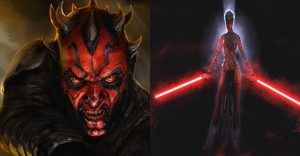How Star Wars Canon Rewrote & Improved Darth Maul’s Backstory & History

The backstory, origin, and lifetime of Darth Maul were explored in great detail in the Star Wars Legends timeline, and the Star Wars canon continuity created an equally compelling new version of the famous Sith Lord. Darth Maul was one of the main antagonists in Star Wars: Episode I – The Phantom Menace, serving as the apprentice and assassin of his master, Darth Sidious, who pulled the strings of the Trade Federation and the Galactic Republic as Palpatine. Maul died at the end of the film, but Legends-era non-movie material explored his background and lifetime before the events of The Phantom Menace. In the post-2014 Star Wars canon, now the franchise’s mainstream and ongoing continuity, Maul had his background retroactively changed, and he was retconned to have survived his bisection on Naboo.
Star Wars Legends, once the official canon and having previously been called the Expanded Universe, is more obscure than the canon timeline, but adheres more closely to the events and characterizations shown in the original six saga films. Darth Maul, for better or worse, had little character development in The Phantom Menace, serving primarily as the embodiment of the Sith Order’s lethal power over the dark side and skills with a lightsaber. Legends-era material explored and expanded on Maul’s characterization, but kept Maul as a character who focuses on his combat abilities more than the leadership and manipulation skills demonstrated by other famous Sith Lords.
Star Wars canon takes significant liberties with the characters and story elements shown in the original and prequel trilogies, differentiating itself from the more consonant Legends continuity but making for equally exciting stories. Case in point: canon’s Darth Maul’s survival and numerous retcons made him a drastically different character than his Legends and The Phantom Menace counterpart, but made for exciting new stories, as shown in his many appearances in Star Wars: The Clone Wars, Star Wars Rebels, and Solo: A Star Wars Story. The Legends continuity expanded on and reinforced the villain shown in The Phantom Menace, while the canon timeline took him in a new direction.
Maul’s Species

In Legends, Darth Maul was a Zabrak, a species from the Mid Rim world of Iridonia who was introduced in The Phantom Menace through Darth Maul and the background Jedi Master Eeth Koth. Zabraks are biologically quite similar to humans, with their crown of vestigial horns being the most obvious visual difference between the two species. Another unique characteristic of Zabraks is their two hearts, which afford them more energy and stamina than a human. Zabrak warriors notably fought with staff weapons, such as quarterstaffs and a ceremonial double-bladed sword called a Zhaboka, making Maul’s signature double-bladed lightsaber a coincidentally fitting weapon, despite Maul’s loyalty being to the Sith Order over all else.
2008’s The Clone Wars contradicted numerous elements of established Legends-era lore, including Maul’s species. The Clone Wars created a sub-species of Zabrak called a Dathomirian, hailing from Dathomir, a planet whose terrain, foliage, and overall appearance were also significantly changed from Legends by the 2008 series. Dathomirians were Force-sensitive beings with intrinsically strong potential to use the dark side of the Force. Male Dathomirians resembled Zabraks, while females appeared similar to the Legends-era Rattataki humanoid species. In Legends, Darth Maul had bright crimson skin with black Sith tattoos all over his body. In canon, male Dathomirians seemed to naturally have red and black (or yellow and black) pigmentation.
Maul’s Origin

Like most Zabraks, Maul hailed from Iridonia in the Legends continuity. As a young child, the boy who’d become Darth Maul was taken from his family by Darth Sidious, who sensed his remarkable Force potential (perhaps before the Jedi Order did). He was raised by Sidious as a Sith, becoming the Dark Lord Darth Maul and becoming an extremely lethal fighter, thanks to Palpatine’s ruthless training and conditioning. Maul’s upbringing and training broke the Sith Rule of Two, which decreed that only two Dark Lords of the Sith could exist at a time, and Sidious was the apprentice of Darth Plagueis at the time. Plagueis knew of Maul’s tutelage under Palpatine and allowed it since Maul was more focused on combat and assassination than the political machinations of his elders.
Various canon sources reestablish Maul as a member of the Nightbrothers, powerful male Dathomirian dark side users who are subservient to the Nightsisters. Maul was one of three children of Nightsister matriarch Mother Talzin. During Maul’s childhood, Palpatine worked closely with Talzin, forming an alliance between the Sith and the Nightsisters and exchanging dark side knowledge, all while taking notice of Maul’s strength in the dark side. When Palpatine had what he wanted, he ended his alliance with Talzin and left Dathomir with Maul, raising and training him as a Sith, similar to his Legends counterpart.
Darth Maul’s Sith Lordship In Legends

Since Darth Maul died at the end of the Invasion of Naboo in Legends, his characterization came from stories set before the events of The Phantom Menace, for the most part. One notable story in an issue of the Star Wars Tales comics (which included a mix of canonical and humorous non-canon stories) explored the origin of Maul’s signature double-bladed lightsaber. During his training under Sidious, Maul faced off against the retired Twi’lek Jedi Master Siolo Ur Manka. After failing to kill his enemy with his single-bladed Sith weapon, Maul constructed an identical lightsaber, fusing the two and learning a new fighting style that suited him better. With his new weapon, Maul killed Manka, a milestone in his training.
Maul also crippled the Black Sun crime organization shortly before the events of The Phantom Menace on Palpatine’s orders. During one of his attacks on the Black Sun on Ralltiir, Darth Maul battled the human witch of Dathomir and Nightsister clan member Mighella, proving to have superior command over the dark side of the Force. Legends overall showed Maul’s Sith Lordship through combat, having the Zabrak warrior strike from the shadows on behalf of his master to ensure that his grand plan of galactic domination ran smoothly.
Maul’s Resurrection In Canon

Most of Maul’s characterization in canon occurred after his supposed death on Naboo. With his life ruined by Obi-Wan’s victory over him and Sidious having abandoned him, Maul led his own path as an unofficial Sith. Canon retconned Maul into being more of a mastermind than a fighter, similar to his adopted father, Palpatine. In The Clone Wars, Maul took control of the Death Watch terrorist group, along with the Black Sun and Pyke Syndicate to form the Shadow Collective, fighting against Republic and Separatist forces during the Clone Wars. As a crime lord and source of chaos throughout the galaxy, Maul continued to torment his nemesis Obi-Wan, outlived his successor, Dooku, and was still alive a mere two years before the events of A New Hope. In one last, futile, attempt on Kenobi’s life, Maul tracked down his old enemy to Tatooine and died dueling the elderly Jedi, concluding the story of Darth Maul in the Star Wars canon timeline.
- Rogue Squadron (2023)Release date: Dec 22, 2023
About The Author


















